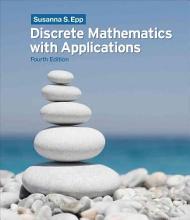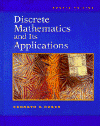Discrete Mathematics
Instructor: Cary Lee, Ph.D.
Office: 70-211 (inside Tech mall)
Telephone: (619) 644 -7894
Office Hours:
e-mail: cary.lee@gcccd.edu
website: www.grossmont.edu/people/cary-lee
Discrete The first part of this word comes from the Latin prefix dis-, which means "apart" or "away". The second half comes from Latin cretus, the past participle of cernere, which means to distinguish.
In nonmathematical English, discrete mathematics is the study of numbers, objects, or processes that are distinct, apart or distinguishable. In mathematical terms, it is the study of structures that are countable (i.e. can be put into a one-to-one correspondence with the set of natural numbers) or even finite. One example is the set of graphs with finite number of vertices. Two graphs are either isomorphic or non-isomorphic and there is nothing in between such as almost isomorphic. Calculus on the contrary is an example of continuous mathematics in which we can find two numbers on the number line as close to each other as we want, or we can approximate a given differentiable function over a compact interval by a polynomial to any degree of accuracy.
Many topics in discrete mathematics have been studied for a long period of time but they are not prominent until high speed computers become more available in the recent decades. This is due to the fact that most problems in discrete mathematics require a large amount of computation that cannot be done by hand in a practical amount of time. Some typical examples are coding, decoding and cryptography.
Discrete mathematics is a broad subject and it is impossible to cover even just the introduction of every topic in this field in a 16 week semester. We can only expect to briefly touch on the following basic, typical, and important topics in this interesting field.
Propositional Calculus
Predicate Calculus
Elementary Number Theory and Methods of Proofs
Sequences and Mathematical Induction
Elementary Set Theory
Relations
Functions
Recursion
Counting Techniques
Graphs and Trees.
 Discrete Mathematics with Applications
Discrete Mathematics with Applications
Fourth edition
Susanna S. Epp
ISBN 0-534-35945-0
Student Solutions Manual
Discrete Mathematics with Applications (4th Edition)
Susanna S. Epp
ISBN: 0-495-82613-8

Discrete Mathematics Numbers and beyond
Stephen Barnett
Addison - Wesley
ISBN 0-201-34292-8
 Discrete Mathematics and its Applications
Discrete Mathematics and its Applications
fourth edition
Kenneth H. Rosen
WCB/McGraw-Hill
ISBN 0-07-289905-0
 Introduction to Discrete Mathematics
Introduction to Discrete Mathematics
Wayne M. Dymacek & Henry Sharp, Jr.
WCB/McGraw-Hill
ISBN 0-07-018566-2
Course Prerequisite: The basic requirement is a grade C or better in Math 280, but the concurrent enrollment of Math 284 will be recommended.
Grades: This course is offered for a grade of A, B, C, D, or F. The grade distribution is as follows:
|
A |
85 - 100% |
|
B |
75 - 84% |
|
C |
65 - 74% |
|
D |
55 - 64% |
|
F |
00 - 54% |
Grades are assigned on an absolute scale, and your work will not be graded on a curve. You get what you earn, and other people's performances have no affect on your grade.
No extra credit.
Assignments:
|
Homework |
100 |
|
5 short quizzes, 25 points possible per quiz |
125 |
|
2 one-hour exams, 100 points possible per exam |
200 |
|
Final exam |
150 |
|
Total points possible |
575 |
Homework will be assigned at the end of each class meeting, and if you are eager to do the exercises in advance, you can get the assignment from the next webpage (see top of page).
Late Homework will receive 2 point penalty per class day.
Expectation of Students:
Supervised Tutoring Referral
1. Students requiring additional help or resources to achieve the stated learning objectives of the courses taken in a Mathematics course are referred to enroll in Math 198, Supervised Tutoring. The department will provide Add Codes.
2. Students are referred to enroll in the following supervised tutoring courses if the service indicated will assist them in achieving or reinforcing the learning objectives of this course:
To add any of these courses, students may obtain Add Codes at the Information/Registration Desk in the Tech Mall.
3. All Supervised Tutoring courses are non-credit/non-fee. However, when a student registers for a supervised tutoring course, and has no other classes, the student will be charged the usual health fee.
Academic Integrity:
Any student who cheats on any of the tests, or disrupts the class or hinders the progress of any other student will be dropped from the class.

8800 Grossmont College Drive
El Cajon, California 92020
619-644-7000
Accessibility
Social Media Accounts